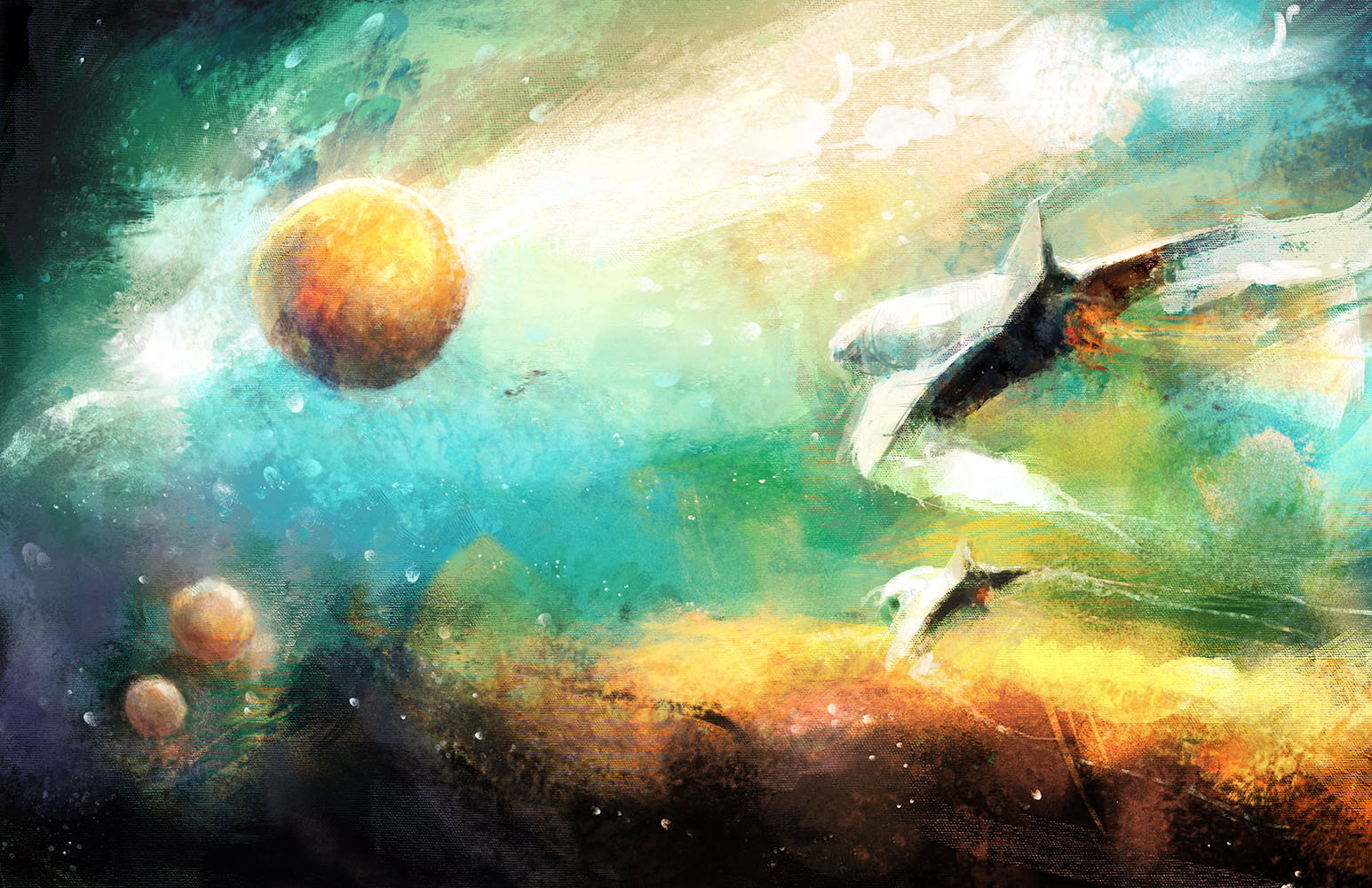We are thrilled to introduce another Rebelle Master Series by Daniel Ibanez. This American artist and educator loves to explore various masters of the brush, thinking about how their style and technique can be translated on digital canvas in Rebelle. Let’s look at the fantasy worlds of John Harris and Frank Frazetta, whose work influenced our imagination over the past few decades.
After the successful studies of John Singer Sargent and J.C. Leyendecker, this time, we will look at the epic fantasy figures and backgrounds of the 20th century. In the first part, we will focus on British illustrator John Harris and his fantasy backgrounds and spaceships. The second part will explore the powerful figures of Frank Frazetta. How we can combine the techniques of these two incredible artists? Let’s find out together.
John Harris
John Harris is a name synonymous with visionary illustration, especially in the realms of science fiction and space art. His work spans more than four decades, characterized by a unique blend of realism, surrealism, and ethereal beauty. Harris's ability to capture the vastness of space, futuristic architectures, and imaginative alien worlds has solidified his place as one of the most iconic illustrators of our time.
Born in London in 1948, Harris showed an early interest in art, often inspired by the works of classic painters like J.M.W. Turner, whose atmospheric landscapes would heavily influence his later work. After studying art and architecture at Exeter University, Harris began his career in the 1970s, contributing illustrations to magazines, advertising campaigns, and book covers. His passion for architecture shines through in his work, which often features massive, awe-inspiring structures that feel both futuristic and timeless.
Find the full master study on our YouTube channel: youtu.be/QqhrK9OCc3g?
Sketch Like John Harris
Even though there are centuries of great painters we can look at, we do not always have to go further into history to find inspiration. John Harris is a working living artist, who mainly works in pastels or oil pastels and oil paints. When looking at his works, we can see how powerful and impactful pastels can be. Planner artists or illustrators for books or magazines could truly empower their work with Rebelle pastels.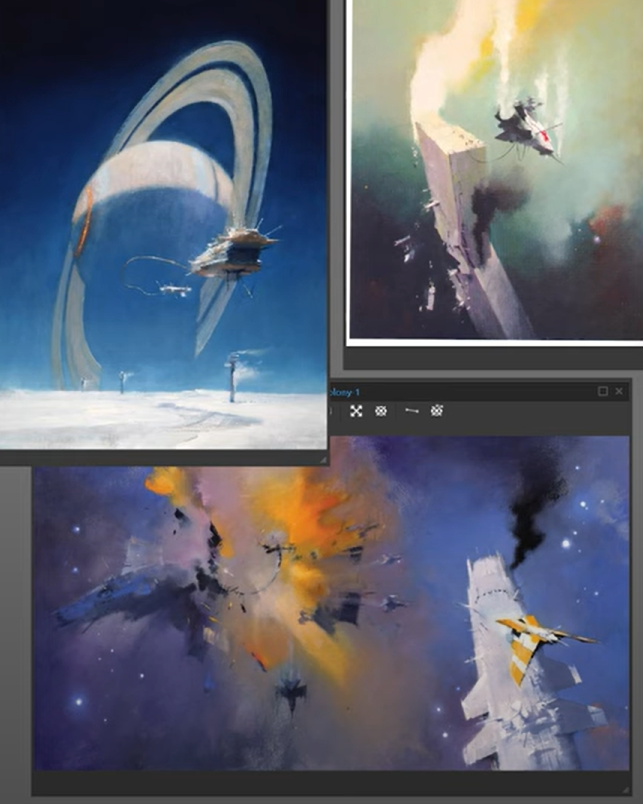 Tip: Build a mood board for your master's study directly in Rebelle. Upload all images you want to explore to the Reference Image library. This will serve you as a great mood board.
Tip: Build a mood board for your master's study directly in Rebelle. Upload all images you want to explore to the Reference Image library. This will serve you as a great mood board.
Even though we could play with different shapes of the brush heads in Rebelle’s Brush Creator and explore the true power of both pastels and oil pastels, we will just stick with the basics for this study. Looking at this Monolith by John Harris, let’s try to sketch it as well. Feel free to color reference directly from the reference image.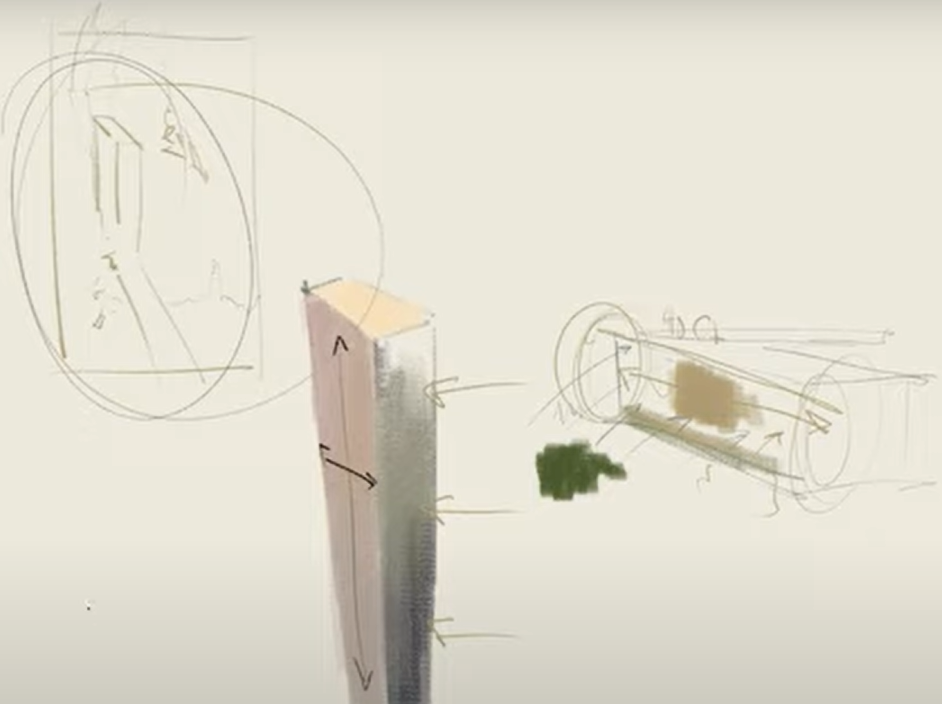 Learn a simple technique from Harris to achieve a realistic look from the get-go. If sketching a plane, a wing, a fuselage, or even a skyscraper, simply something with a geometric shape, tool that can shift values or color temperature easily across the geometric shape is crucial. In this case, a darker wax pencil will help when working the top-to-bottom transition and also front-to-back transition with different values. These little color shifts and tones represent the simple way to achieve realistic results. When looking at the original picture by John Harris, there is quite simple geometric designs with beautiful blending. The background is very interesting, these dark tones on the bottom create a great backdrop for ships or structures. It has a nice contrast and that’s all it needs.
Learn a simple technique from Harris to achieve a realistic look from the get-go. If sketching a plane, a wing, a fuselage, or even a skyscraper, simply something with a geometric shape, tool that can shift values or color temperature easily across the geometric shape is crucial. In this case, a darker wax pencil will help when working the top-to-bottom transition and also front-to-back transition with different values. These little color shifts and tones represent the simple way to achieve realistic results. When looking at the original picture by John Harris, there is quite simple geometric designs with beautiful blending. The background is very interesting, these dark tones on the bottom create a great backdrop for ships or structures. It has a nice contrast and that’s all it needs.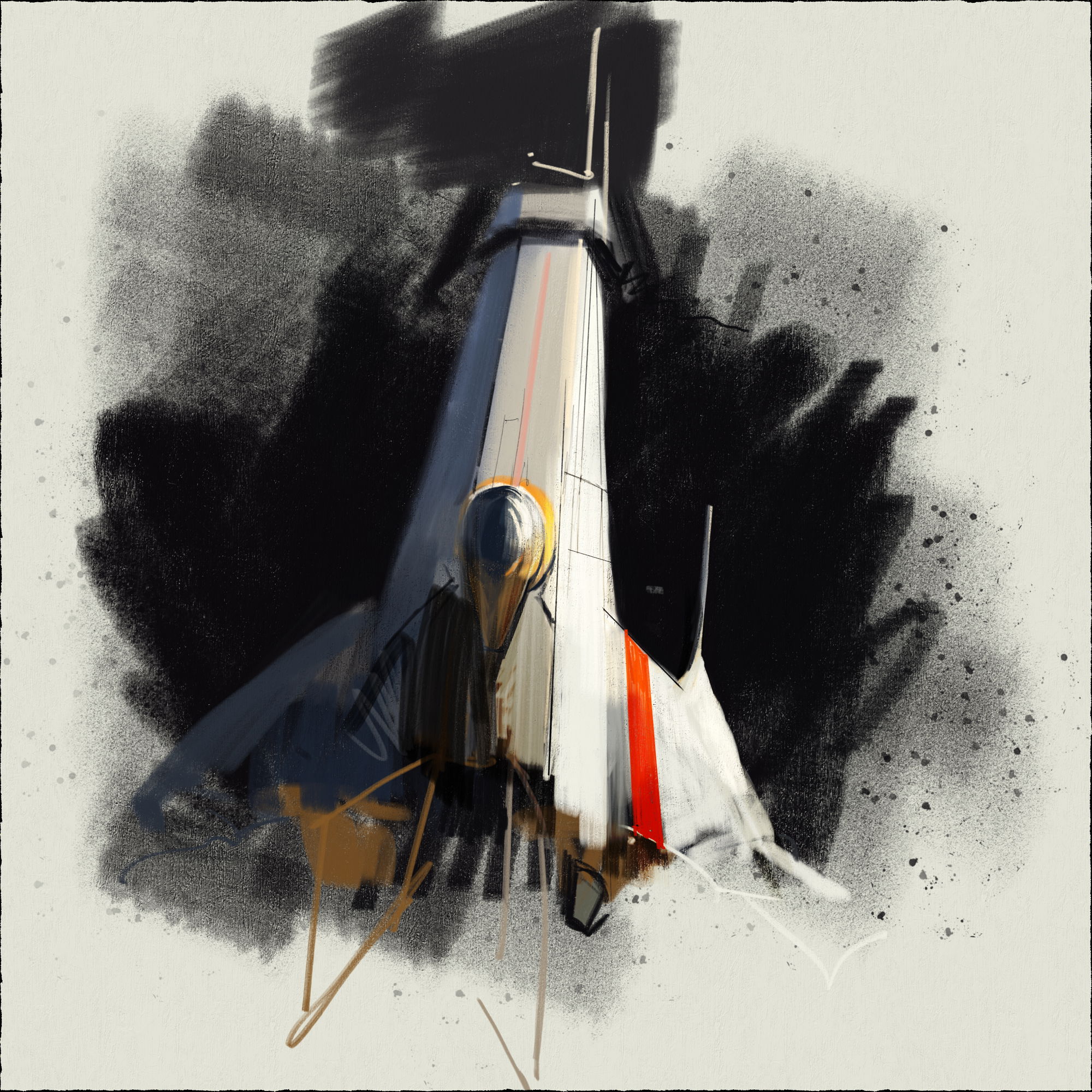 That’s one thing to love about John Harris. There is no need to spend hours drawing lanes and lanes of city streets with cars and traffic and a perfect perspective. His artworks contain a very simple design communicating the feeling that it is placed in a world and it is executed beautifully.
That’s one thing to love about John Harris. There is no need to spend hours drawing lanes and lanes of city streets with cars and traffic and a perfect perspective. His artworks contain a very simple design communicating the feeling that it is placed in a world and it is executed beautifully.
Placing Structures
Before approaching a full illustration in Harris´s style, let’s focus on the placement of the structures in his artwork. The composition is very minimalistic, elegant, and evocative. The uniqueness of his work is that there can be very little on the canvas, but it expresses a lot and feels like a lot. Sketching out a few structures while applying these principles can serve as a preparation for a full illustration. Keep in mind the visual language of John Harris and doodle a few things.
Full Illustration
Moving on from pastels, the oil paints are a great choice for a full illustration in the style of John Harris. After choosing the right values for the underpainting, a soft light blend layer will serve to add light and shadow to the painting. In this step, work on fog, debris, or similar elements of the atmosphere. It is not something we typically think about when we think of space. Usually, it would be just a dark background of nothing. However, Harris approaches this differently. The goal is to make those worlds feel whole and approachable, so he adds color and objects to them. It is not just a cold harshness of space, it is an atmosphere full of color, habitation, transportation, construction, and so on. His illustrations are full of action and movement. Create something the viewer can grab onto, empathize, or connect with. They will be excited to step into this world and take part in it.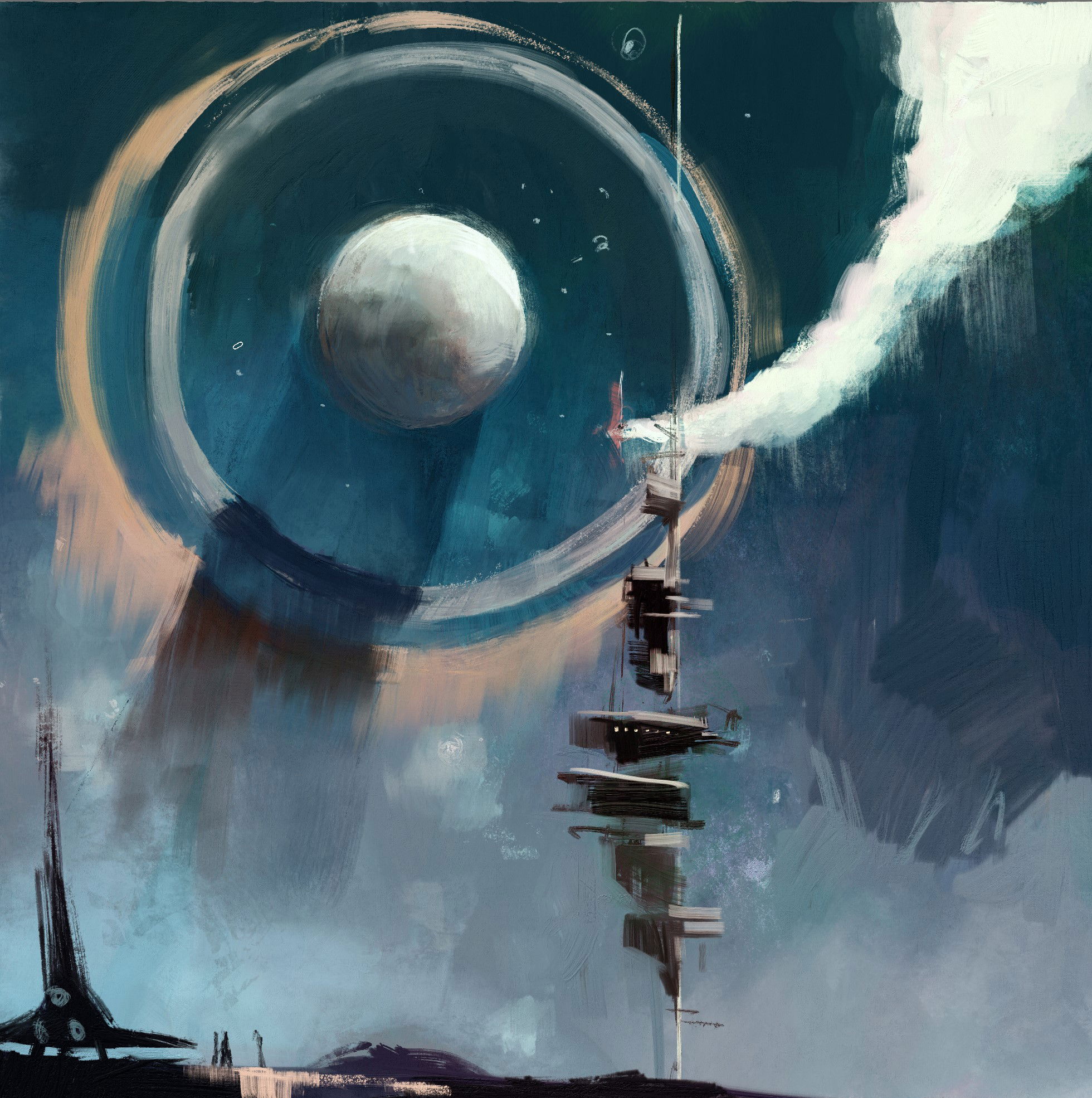 Keep in mind the two-step approach going on here. In the nearer ground, there is a ship flying in out of the top right and debris falling off the engine. While in the background, the rings of light seem to be pulling down as well as the space itself full of atmosphere and texture. And then don’t forget to imagine yourself being a part of that world, twinkling stars or something. Practice until you understand all these dimensions. Keep asking, where can I tie in some familiarity, how can I make this epic huge sci-fi spectrum of experience while bringing it down in a way that it can still feel intelligible?
Keep in mind the two-step approach going on here. In the nearer ground, there is a ship flying in out of the top right and debris falling off the engine. While in the background, the rings of light seem to be pulling down as well as the space itself full of atmosphere and texture. And then don’t forget to imagine yourself being a part of that world, twinkling stars or something. Practice until you understand all these dimensions. Keep asking, where can I tie in some familiarity, how can I make this epic huge sci-fi spectrum of experience while bringing it down in a way that it can still feel intelligible?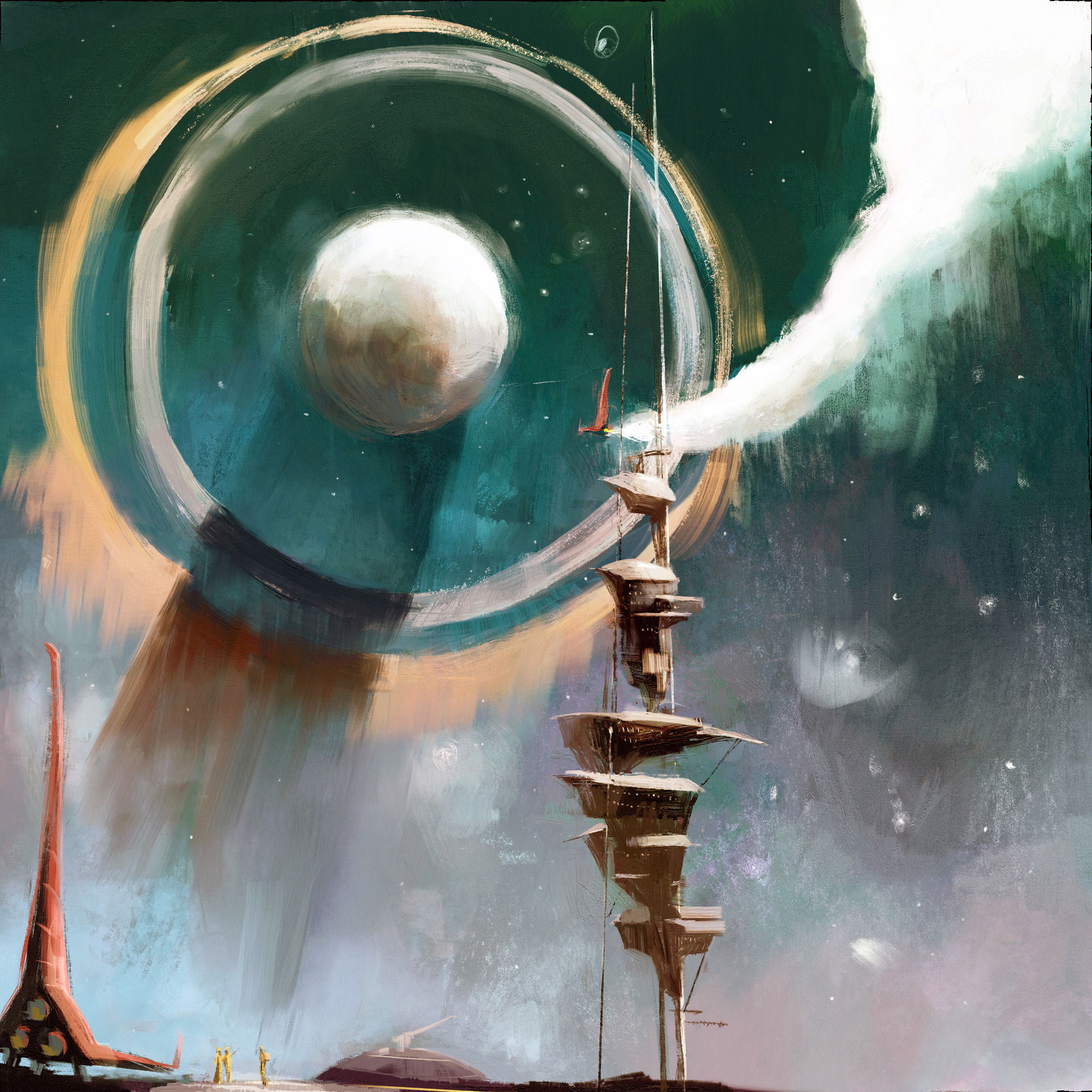 Got it? Then that’s it for the John Harris master's study. Keep those atmospheres in mind, because in the next part, we will try to combine them with Frank Frazetta’s epic characters.
Got it? Then that’s it for the John Harris master's study. Keep those atmospheres in mind, because in the next part, we will try to combine them with Frank Frazetta’s epic characters.
Stay tuned,
Escape Motions Team
-----
Daniel Ibanez is a fine artist and illustrator who works out of beautiful Colorado. He grew up plein air painting mountain landscapes and western imagery. He has a love of painting the human figure, portraits, and landscapes. Daniel has worked on films, comics, video games, and tabletop games. While his range of subjects is diverse, all of his work is rooted in his traditional art background. He has been an oil painter since he was 13 years old. His work covers a wide spectrum of subjects, from sci-fi illustrations to alla prima landscapes. He has a digital portrait painting class with Domestika and a growing YouTube channel for tutorials and demonstrations. Find him on Instagram and say hello!

